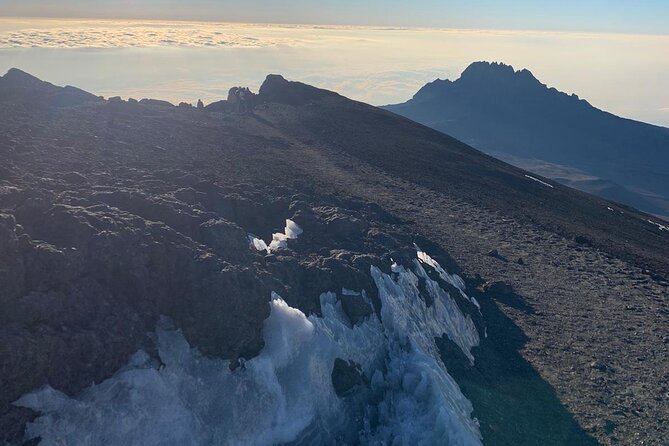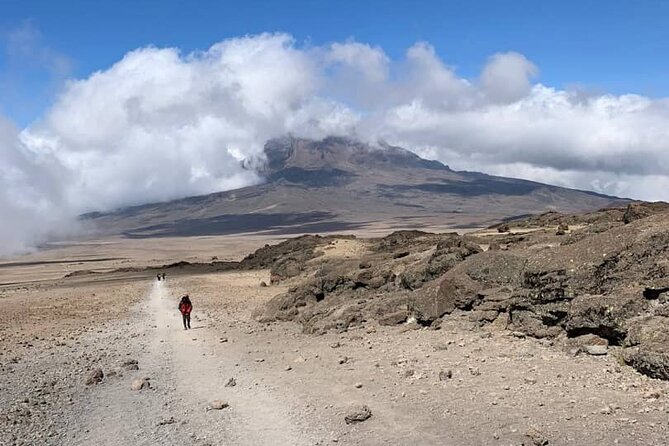Towering over the vast expanse of East Africa, Mount Kilimanjaro beckons adventurous trekkers to its slopes. The Lemosho Route, one of the most scenic and less-crowded paths to the summit, offers a captivating journey through diverse ecosystems. From the lush Lemosho Glades to the rugged alpine terrain, this 8-day trek promises an unforgettable experience for those seeking a challenge. With comprehensive support and guidance, hikers can conquer Kilimanjaro’s impressive heights, but the route’s demands on physical fitness cannot be underestimated. Discover why the Lemosho Route is a premier choice for those seeking an adventurous ascent of Africa’s highest peak.
Key Points

- The Lemosho Route on Mount Kilimanjaro is a scenic and less crowded path to the summit, spanning 8 days through diverse ecosystems.
- Strong physical fitness is required to undertake the strenuous trek, which involves a total elevation gain exceeding 14,000 feet.
- The comprehensive tour package includes private transportation, guides, porters, meals, and essential services, providing a seamless and value-focused experience.
- Accommodation is provided in comfortable hotels/lodges in Moshi before and after the trek, as well as campsites on the mountain during the hike.
- Safety is prioritized, with the inclusion of portable oxygen tanks, oximeters, and a first-aid kit, along with recommended gear for the challenging terrain.
Overview and Location
Mount Kilimanjaro’s Lemosho Route is situated in Moshi, Tanzania, where it has earned a 5.0 overall rating from 10 Viator and Tripadvisor reviews.
This route is one of the most scenic and less crowded paths to the summit of Africa’s highest mountain. It’s a challenging trek that requires a high level of physical fitness, but the stunning views and sense of accomplishment make it well worth the effort.
The route offers a chance to explore the diverse ecosystems of Kilimanjaro, from the lush rainforests at the base to the harsh, glacial landscapes near the summit.
With its reputation for an exceptional experience, the Lemosho Route is a top choice for adventurous trekkers.
You can also read our reviews of more tours and experiences in Moshi.
Inclusions and Exclusions

The Lemosho Route package includes private transportation, all fees and taxes, guides, cook, and porters, drinking water and hot water for washing, portable oxygen tanks and ox meter, a portable first-aid kit, 6 breakfasts, 7 lunches, 6 dinners, accommodation in Moshi before and after the trek, and travel insurance, as well as laundry service. However, the package excludes personal items and toiletries, personal mountain climbing gear, flight tickets, and gratuities/tips for guides, cook, and porters. This helps ensure travelers only pay for what they need, while still providing a comprehensive experience.
| Inclusions | Exclusions |
|---|---|
| Private transportation | Personal items and toiletries |
| All fees and taxes | Personal mountain climbing gear |
| Guides, cook, and porters | Flight tickets |
| Meals and accommodation | Gratuities/tips |
Meeting and Pickup

The meeting point for the Lemosho Route trek is in Moshi, Tanzania, which you can open in Google Maps. Pickup options are available, and the activity ends back at the original meeting point.
It’s important to confirm the exact start time with the local provider in advance.
The trek offers several convenient meeting and pickup arrangements:
- Private transportation can be arranged to pick you up from your accommodation in Moshi.
- You can also meet the group at the designated meeting point in Moshi.
- The activity concludes back at the original meeting point in Moshi.
- Be sure to confirm the exact start time with the local provider to ensure a smooth start to your Kilimanjaro adventure.
Itinerary and Route
This Lemosho Route trek up Mount Kilimanjaro typically takes 8 days to complete, following an established itinerary through diverse landscapes.
The journey begins at Lemosho Glades, where trekkers start their ascent through lush, forested areas. Over the next few days, they’ll traverse moorland, cross alpine deserts, and reach the Shira Plateau.
The route then leads to Barranco Wall, a steep rocky climb, before reaching Barafu Camp at an elevation of over 15,000 feet. Finally, trekkers make their summit push to Uhuru Peak, the highest point in Africa, before descending back down the mountain.
Throughout the trek, hikers are supported by experienced guides, cooks, and porters to ensure a safe and successful journey.
Difficulty and Fitness

Climbing Mount Kilimanjaro via the Lemosho Route requires a strong physical fitness level, as the trek involves strenuous hiking over multiple days at high altitudes. This route is considered one of the more challenging options, with a total elevation gain of over 14,000 feet (4,267 meters).
Trekkers should be prepared for:
- Steep ascents and descents through rugged terrain
- Exposure to cold, wind, and potential altitude sickness symptoms
- Long hiking days, often 6-8 hours or more
- Carrying a daypack with essential gear and supplies
While the Lemosho Route offers a more gradual and scenic approach, it’s crucial that participants have the endurance and stamina to handle the physical demands of this trek. Proper training and preparation are essential for a successful and safe climb.
Accommodation and Meals
During the Mount Kilimanjaro Lemosho Route trek, trekkers enjoy accommodation in Moshi before and after the climb, as well as camp accommodations on the mountain.
In Moshi, travelers stay in comfortable hotels or lodges, which provide a comfortable transition before and after the strenuous trek.
On the mountain, hikers sleep in campsites at designated locations along the route.
The trek includes 6 breakfasts, 7 lunches, and 6 dinners, prepared by the expedition’s cook. Meals are hearty and nutritious, providing the necessary fuel for the long days of hiking.
Clean drinking water and hot water for washing are also provided throughout the trek.
The all-inclusive nature of the trek ensures trekkers can focus on the adventure without worrying about logistics.
Safety and Equipment
With the comfortable accommodations and hearty meals taken care of, trekkers can then turn their focus to the essential safety and equipment considerations for the Mount Kilimanjaro Lemosho Route.
Proper preparation and the right gear are crucial for a successful and safe climb on this demanding trek. The tour includes portable oxygen tanks and oximeters, as well as a first-aid kit, to ensure trekkers’ well-being at high altitudes.
Plus, the following equipment is strongly recommended:
- High-quality, waterproof hiking boots with good traction
- Warm, layered clothing to adapt to changing weather conditions
- Sun protection, including hats, sunglasses, and sunscreen
- Trekking poles to provide stability and reduce strain on the joints
Pricing and Booking

The cost for the Mount Kilimanjaro Lemosho Route trek starts at €2,720.99 per person, offering a lowest price guarantee. Travelers can book this activity directly through the local provider, with free cancellation available up to 6 days prior to the start date. The tour includes a range of amenities, from private transportation and accommodation to meals, equipment, and insurance. Prospective trekkers should be aware of the exclusions, such as personal items, gear, and gratuities. To help visualize the pricing, here’s a breakdown:
| Inclusions | Exclusions |
|---|---|
| Private transport | Personal items |
| All fees and taxes | Personal gear |
| Guides, cook, porters | Flight tickets |
| Meals and accommodation | Gratuities/tips |
| Travel insurance | – |
This comprehensive package ensures a seamless and well-supported Kilimanjaro climb along the Lemosho Route.
Frequently Asked Questions
What Is the Best Time of Year to Climb Kilimanjaro?
The best time to climb Kilimanjaro is typically during the dry seasons of January-March and June-October when weather conditions are most favorable. Crowds are lower and temperatures are milder, making for an ideal trekking experience.
Can I Extend My Stay in Tanzania After the Trek?
Absolutely, you can extend your stay in Tanzania after the trek. Many hikers choose to explore other parts of the country, like the Serengeti or Zanzibar, to make the most of their time in the region.
What Is the Weather Like on the Lemosho Route?
The weather on the Lemosho Route can be quite variable. Temperatures range from warm and sunny at the base to freezing at the summit. Hikers should expect rain, snow, and high winds, and pack appropriate clothing and gear to stay comfortable throughout the trek.
Do I Need Any Special Permits or Visas to Climb Kilimanjaro?
To climb Kilimanjaro, climbers need a valid passport, Tanzanian visa, and a Kilimanjaro National Park climbing permit. These permits must be obtained in advance and can be arranged through the tour operator or independently.
What Are the Typical Group Sizes for This Tour?
According to the information provided, this tour has a maximum group size of 15 travelers. The tour operator specifies that the typical group size is kept small to provide a more personalized experience for participants.
Recap
The Lemosho Route is a captivating and challenging ascent of Mount Kilimanjaro.
With its scenic beauty, less crowded trails, and comprehensive support, it’s an ideal choice for adventurous hikers seeking an unforgettable trekking experience.
However, the demanding terrain and significant elevation gain require strong physical fitness.
The Lemosho Route offers a truly remarkable journey to the summit of Africa’s highest mountain.
More Tour Reviews in Moshi
Not for you? Here's more things to do in Moshi we have recnetly reviewed
- 7 Days Mid Range Tanzania Wildlife Safari
- Private Multi Day Safari Tour in Tanzania
- Private Kilimanjaro Hike 7 Day Lemosho Route
- 1-Day Moshi Villages Bike Tour
- Chemka Hotsprings
- 6-Days Mt. Kilimanjaro Bike Trek -With- BURIGI CHATO SAFARIS CO L.T.D
- 7 Days Lemosho Route Kilimanjaro Climbing | Solely Tours
- West Kilimanjaro Cycling Adventures
- 8 Days Lemosho Route Climbing Mt. Kilimanjaro
- Moshi City Bike Day Trip
- The Best 7 Days Kilimanjaro Hiking Machame Route in & 2025
- 6 Days Tanzania Budget Camping Safari With Migration
